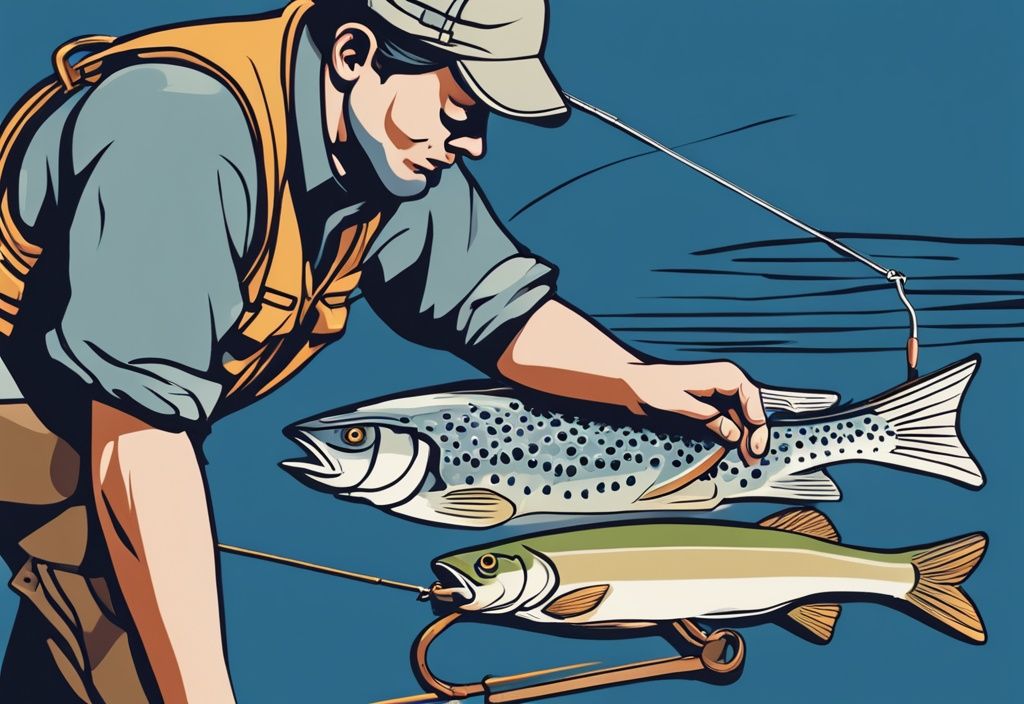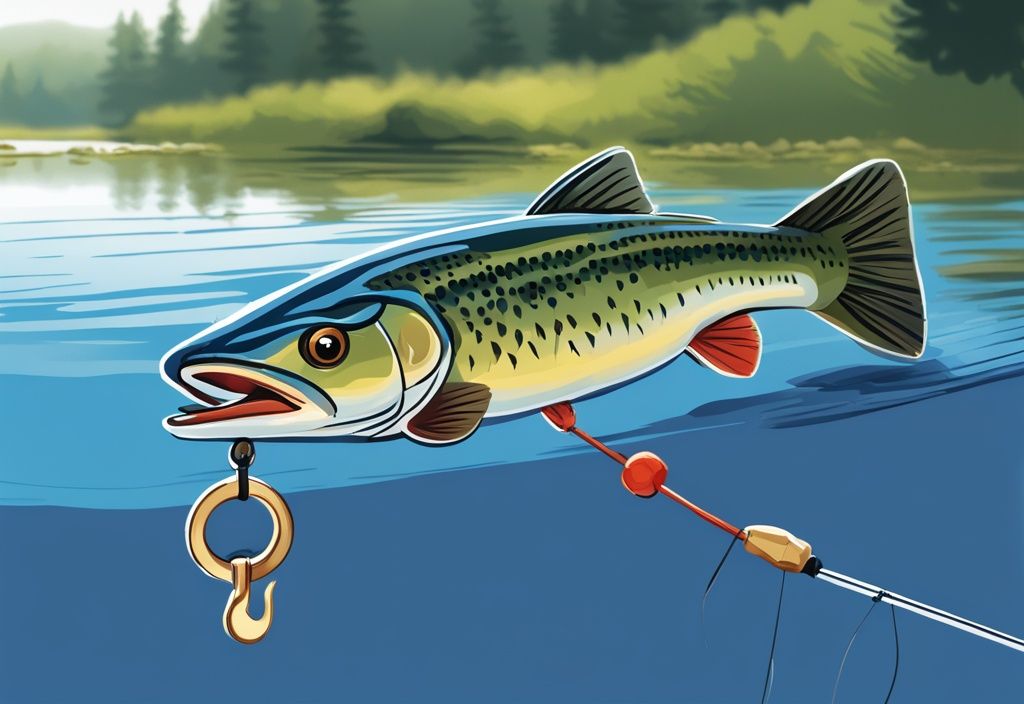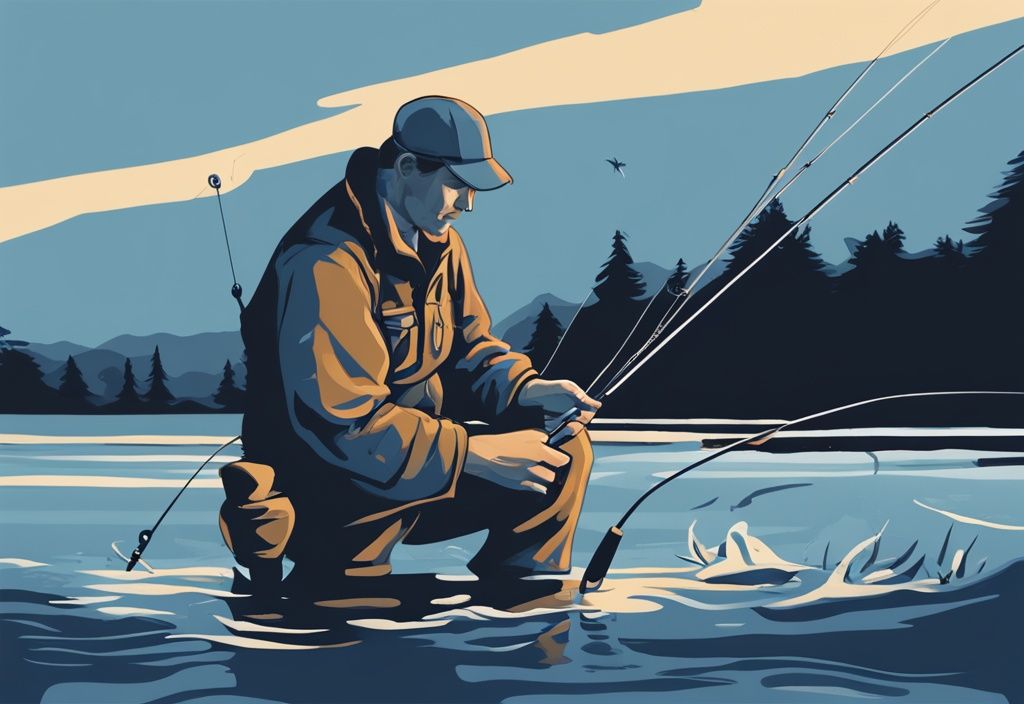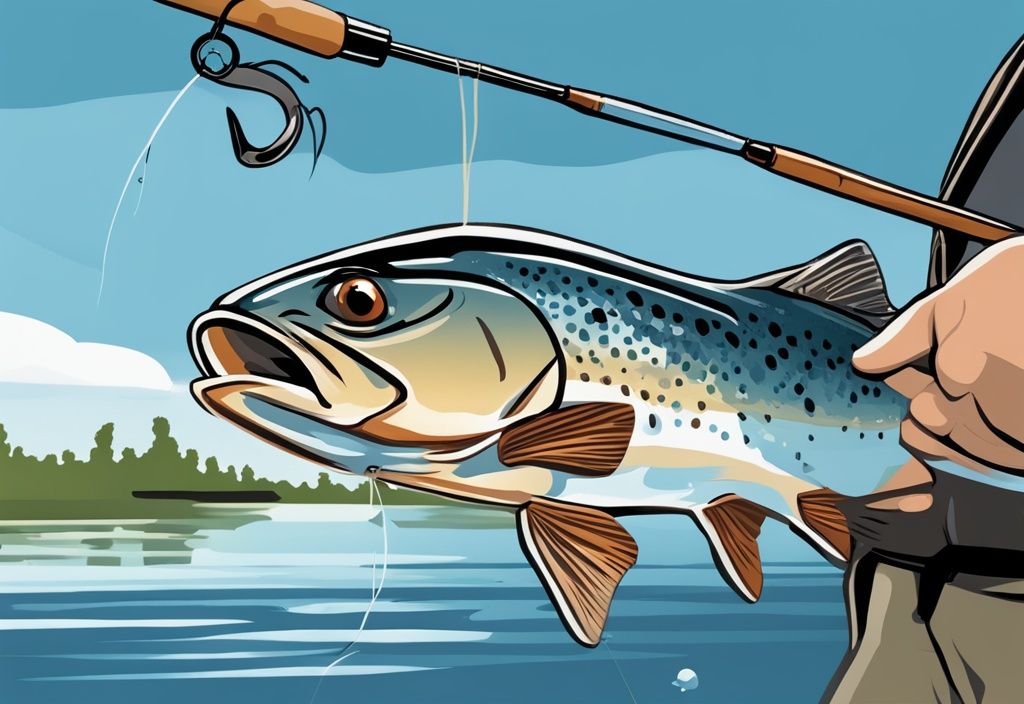Ever wonder why some anglers always haul in the big ones, while you’re left nibbling at flies? The secret could be as simple as the tippet they use. In fly fishing, a tippet isn’t just a fancy word – it can be the game-changer between a catch of the day story or fishing fables.
As an angler with more than two decades of experience, the tippet’s importance isn’t lost on me. Think of the tippet as the unsung hero of your fly fishing gear. The nearly invisible link connecting your fly to your leader, a prime reason that the fish can’t spot the leader and dart away.
In this guide, I’m going to demystify what a tippet is in fly fishing and how it can transform your fishing experience. Through my Prime Guide to Tippets, you’ll get clued up on why choosing the right tippet material could make or break your next fishing expedition. So, whether you’re a rookie angler or a seasoned pro, stick with me to amp up your fishing game.
What is a Tippet in Fly Fishing?
The tippet, an essential component in fly fishing, serves as the final segment of the leader that directly connects to the fly. Typically made from materials such as nylon, fluorocarbon, or copolymer, the tippet is designed to be thin and almost invisible in water, allowing for a more natural presentation of the fly. This is crucial, as it helps mimic the movements of insects and nymphs, thereby making the lure more attractive to fish.
One of the key functions of the tippet is to extend the length and lifespan of the leader. By adding a tippet, anglers can replace only this section when it becomes worn or damaged, instead of replacing the entire leader. This not only prolongs the integrity of the leader but also offers the flexibility to adjust the overall length of the setup according to specific fishing conditions.
The primary goal of using a tippet is to present the fly to fish in the most natural way possible, without the fish detecting the line. Given its fine diameter and clear composition, the tippet significantly reduces the chances of spooking fish, increasing the likelihood of a successful catch.
Tippets are conveniently supplied on spools, making them easy to carry and use. Anglers can build, repair, or tweak their leaders on the go, ensuring their gear is always optimized for the current fishing scenario. This modularity is particularly beneficial for maintaining an effective and efficient fishing setup.
The Role and Importance of Tippets in Fly Fishing
In fly fishing, understanding each component of your gear is vital. The tippet, though slender and often overlooked, plays a pivotal role in your fishing success. It serves multiple important functions, ensuring your fly remains enticing to fish, and your line stays protected.
Maker of Invisible Connection
So, what is a tippet in fly fishing? It’s the element that transfers motion from the leader to the fly, creating lifelike movements that mimic insects in their natural habitat. With the leader, tippet, and fly working in harmony, your setup is fine-tuned to deceive fish with uncanny realism. Believe me, that little piece of line makes a world of difference.
Protector of Your Fishing Line
Regularly checking your tippet for wear and tear is crucial. Ever notice how wear can sneak up on you? Ensuring your tippet is in top shape means your entire setup remains strong and ready for action. Understanding what is a tippet in fly fishing isn’t just about knowing its role; it’s about appreciating how it keeps your gear durable and effective for those memorable fishing trips.
So next time you’re out by the river, remember the humble tippet. It’s there, quietly doing its job, making sure every cast, every drift, and every catch goes smoothly.
Decoding Tippet Material and Measurements
Understanding ‘X’ Ratings
To truly grasp what is a tippet in fly fishing, it’s crucial to get acquainted with the ‘X’ rating system. This rating classifies the diameter of the tippet material. Imagine this: a 3X tippet is thicker than a 5X tippet; the 5X has a diameter of .006 inches, while the 3X measures .008 inches. The beauty of the X ratings lies in their simplicity, offering an industry-standard measure that eases the selection process, even though breaking strength can vary across brands. So, knowing your gear’s specifics is key to ensuring top performance on the water.
The Difference in Diameter and Strength
One of the essential aspects of choosing a tippet is finding the sweet spot between invisibility and strength. A thinner tippet, like a 5X, with its higher X rating, provides lower visibility, making your fly appear enticingly natural. But beware, its thinner diameter also means lower breaking strength, risking a break during a fierce strike. On the flip side, a 3X tippet offers greater breaking strength due to its thicker diameter. However, this comes at the cost of higher visibility, potentially alerting those wary fish and reducing your chances of a catch. Mastering this balance is key to achieving the perfect blend of presentation and strength suited to your fishing conditions.
Material Variations that Affect Breaking Strength
The material of a tippet plays a pivotal role in its strength, flexibility, and resistance to abrasion. Take nylon tippets; they’re flexible and boast good knot strength but may fall short in abrasion resistance. Fluorocarbon tippets, by contrast, are outstanding underwater thanks to better abrasion resistance and lower visibility, making them ideal for nymph fishing. Monofilament is a dream for dry fly fishers due to its buoyancy. Meanwhile, copolymer tippets aim to marry the best of nylon and fluorocarbon, offering moderate sink rates with decent flexibility. Savvy anglers often pack an array of these materials, adapting to varying scenarios to maximize their success. Picking the right tippet for your fishing needs can make all the difference between a story of “the one that got away” and a photo with your catch of the day.

Types of Tippet Materials: Nylon, Fluorocarbon, and Copolymer
Tippet materials in fly fishing are a key component that can make or break your angling success. Understanding the distinct attributes of nylon, fluorocarbon, and copolymer will enhance your fly presentation, ensuring you can adapt to various fishing scenarios with ease.
Nylon Tippets
Nylon tippets, also known as monofilament tippets, are popular among fly fishers due to their buoyant qualities. Imagine casting your dry fly and watching it dance on the water’s surface, perfectly mimicking a natural insect. This is where nylon shines. It’s flexible, providing better knot strength and ease of handling. However, brace yourself for some wear and tear; nylon is more prone to abrasion and lacks the durability found in other tippet materials.
Fluorocarbon Tippets
Fluorocarbon tippets are the unsung heroes for nymph and streamer fishing. Picture your fly diving below the water’s surface, nearly invisible to the fish thanks to the refractive properties of fluorocarbon. This material is tougher, with exceptional abrasion resistance, making it ideal for rocky waters and tough catches. Its higher density means it sinks faster, getting your fly to the desired depth quicker and with precision.
Copolymer Tippets
Copolymer tippets strike a balance between the flexibility of nylon and the strength of fluorocarbon. They’re engineered from a combination of different polymers, giving them a unique mix of qualities. Whether you’re casting in calm or turbulent waters, copolymer tippets provide the versatility needed for various fishing scenarios. Their flexibility allows for delicate presentations, while their strength ensures you can handle larger fish. Plus, they boast better knot strength than monofilament and maintain lower visibility in water compared to nylon.
Choosing the Right Material
Choosing the right tippet material depends on your fishing conditions and the species you’re targeting. Need to keep your dry fly afloat? Nylon’s buoyancy is your best bet. Heading for clear, rocky waters? Go for fluorocarbon for its toughness and invisibility. Looking for an all-around performer? Copolymer tippets offer a great mix of strength and flexibility.
No matter the material, a tippet’s role in fly fishing is crucial. It enhances the natural presentation of your fly, making your angling experience not just productive but deeply satisfying. If you’re wondering what time of day is best for fishing, understanding the traits of each material—nylon, fluorocarbon, and copolymer—ensures you choose the right tool for the job, leading to unforgettable days on the water.
Guide to Choosing the Right Tippet
A proper tippet enhances your control and presentation of the fly, ensuring a more natural and enticing movement. Selecting the right tippet size is crucial for a successful fishing experience.
Matching Tippet Size with Fly Size
Understanding what is a tippet in fly fishing can make a world of difference in your angling adventures. Think of the tippet as the vital link between you and the catch. This thin, nearly invisible line must be chosen carefully to match your fly size to ensure your presentation looks naturally irresistible to fish.
- Larger flies: When you’re casting beefy streamers or heavily weighted nymphs, you’ll need a stronger tippet. This extra muscle helps withstand the weight and the forces in play when you’re casting and retrieving. Imagine trying to reel in a heavy-duty suitcase with a piece of string—it just wouldn’t hold up.
- Smaller flies: For those delicate presentations, like dry fly fishing, thin is in. A dainty, subtle tippet helps maintain the gentle drift, preventing the fish from spooking. Picture gently placing a leaf on a still pond—you want that same effortless grace.
Fishing Conditions That Influence Your Choice
The conditions you fish in can make or break your tippet choice. Here are key factors to ponder:
- Fly Size: This is a biggie. Your tippet has got to vibe with your fly size. Thick tippets are for your heavier squad, while thin tippets are the wingmen for the smaller flies. It’s like matching footwear to the terrain.
- Water Type: Clear, calm waters demand stealth. You’ll want a less visible tippet, often denoted by a higher X rating. On the flip side, in murky or fast-moving waters, you can afford a thicker tippet as the fish won’t notice as easily. Think of it like blending into your surroundings—sometimes you need camo, sometimes you can go bright.
- Fish Species: The bigger and more aggressive the fish, the sturdier your tippet needs to be. For smaller, more cautious fish, a thinner tippet does the trick. It’s all about reading your audience and adjusting your approach.
- Wind Conditions: Ah, the wind—both a blessing and a curse. Wind can mess with your casting precision. Here, a slightly thicker tippet can help you muscle through the resistance, ensuring your fly lands where you aim.
Adapting your tippet to the environment and your target fish is key. Whether you’re battling the elements or trying to outsmart a particularly skittish trout, the right tippet makes all the difference. Happy fishing!
Essential Knots for Tippet Connections
Understanding what is a tippet in fly fishing is crucial for achieving strong and secure connections. Let’s dive into the knots that make this possible.
Mastering the Surgeon’s Knot and Blood Knot
Effective knot tying is essential for maintaining the strength of tippet material. If you’re wondering what is a tippet in fly fishing, it’s a thin line attached to the end of your leader to which you tie your fly. Its strength is paramount to your gear’s performance. Making secure connections ensures that your tippet performs effectively without losing strength.
Surgeon’s Knot: A Go-To for Quick and Strong Connections The surgeon’s knot is a favorite because it’s simple yet robust. Imagine you’re in a hurry and need a knot you can trust—just overlap the two lines, create a loop, pass the working ends through the loop twice (or three times for extra security), and tighten evenly. This knot retains most of the tippet’s original strength, perfect for those quick setup moments.

Blood Knot: Balancing Strength and Flexibility The blood knot is a bit more sophisticated, excellent for connecting lines of similar diameter. To tie it, overlap the line ends, twist one around the other five to seven times, then wrap the second line similarly. Pass the loose ends back through the center in opposite directions and tighten slowly. Though it takes a bit longer to tie than the surgeon’s knot, the result is a smooth, streamlined connection—ideal for delicate fly presentations.
Enhancing Knot Security For the best performance, moisten your tippet material before tightening any knot. This reduces friction and helps maintain the line’s integrity. Regularly checking your knots for wear or slippage is crucial as even the best knots can degrade over time with use and exposure to the elements.
Mastering these knots means fewer lost flies and catches, making your time on the water more successful and enjoyable. By understanding the role of a tippet in fly fishing and the importance of reliable knots, you’ll fish with greater confidence and finesse.
Tips for Tippet Maintenance and Care
The following tips will help you maintain the longevity and efficiency of your tippet, ensuring that you are always ready for the perfect cast and catch. Understanding what is a tippet in fly fishing includes knowing how to care for it properly.
Spotting Frays and Weak Spots
When it comes to what is a tippet in fly fishing, keeping an eye on the condition of your tippet is paramount. You’ll want to regularly inspect it for frays or weak spots. Imagine hooking that big one and losing it because of a tiny nick in the line. Frustrating, right? Always run your fingers along the tippet, feeling for any rough patches or inconsistencies. If you do detect any, cut that section out and replace it.
It’s like catching those small issues before they become big problems. This ensures your tippet is in top shape, ready for the next catch. Trust me, taking these extra few moments can make the difference between telling a great fish tale and “the one that got away.”
Proper Disposal of Used Tippets
When thinking about what is a tippet in fly fishing, we mustn’t overlook the importance of proper disposal. Old tippets, especially those made of fluorocarbon, don’t break down easily and can harm the environment. It’s essential to carry a small container or bag for collecting used tippet material.
You’d be surprised how quickly these discarded pieces can accumulate, and tossing them thoughtlessly goes against the very spirit of fishing. Dispose of them in designated waste containers or recycling programs if available. This practice is vital for protecting wildlife and preserving our beloved fishing spots for future adventures. Remember, a true angler respects nature just as much as the thrill of the catch. For those looking to enhance their fishing gear, exploring the top Daiwa spinning reels can be a great start.
Are Tippets Ideal for Beginners? A Detailed Insight
Learning what is a tippet in fly fishing can dramatically enhance a beginner’s angling journey, offering practical and strategic benefits.
Why Beginners Should Consider Using a Tippet
Understanding what is a tippet in fly fishing is crucial for beginners who want to improve their angling capabilities. While some newcomers may initially overlook the use of a tippet, mastering this component can significantly benefit their efficiency and success rates.
For starters, learning to incorporate a tippet into your setup can protect the leader from frequent changes and potential damage. Picture this: a beginner, excitedly changing flies while practicing, only to find the leader gradually shortening. The tippet acts as an extension, allowing for multiple fly changes without affecting the leader’s length, thus prolonging its lifespan.
Moreover, using a tippet can help beginners transition smoothly to more advanced techniques. Gaining proficiency in attaching tippets and flies enhances skill sets that will be invaluable as they progress in the sport. This adaptability also helps in tackling different fishing conditions effectively.
Another vital role of the tippet is its ability to present the fly naturally to fish without being visible. This is fundamental for attracting fish and improving catch rates. Beginners who familiarize themselves with this aspect early on can see noticeable improvements in their fishing outcomes.
Additionally, the tippet provides a safety mechanism by absorbing some of the stress and shocks when a fish strikes. This helps protect the main line from breaking, ensuring better equipment longevity and less frustration for a novice angler.
Lastly, learning to use a tippet allows beginners to understand and appreciate the nuances of fly fishing gear. Getting comfortable with tippet materials, measurements, and knots builds a strong foundation for more advanced fly fishing expeditions in the future.
By understanding what is a tippet in fly fishing and incorporating it into their routines, beginners set themselves up for a more rewarding and proficient fishing experience.
FAQ: Answering Your Queries about Tippets
Tippets in fly fishing—those indispensable pieces of line that can make or break your fishing day. Here’s everything you need to know about their functions, measurements, ideal materials, and when to replace them.

What are the primary functions of a tippet in fly fishing?
- Why is the tippet so indispensable? Well, it plays a crucial role in presenting the fly as naturally as possible to those elusive fish. Imagine trying to convince a fish that your fly is a real insect; the tippet’s job is to help you do just that.
- But it’s not just about fooling the fish. The tippet also protects the more expensive leader from damage, acting as a sacrificial barrier. Now that’s what I call working double duty!
How are tippets measured accurately?
- Ever noticed those X ratings on a tippet spool and wondered what they meant? Tippets are graded using these X ratings and they’re also measured by pounds for their breaking strength.
- Here’s a quick tip: Higher X numbers mean thinner diameters. So, a 6X tippet is much finer than a 3X. Keep that in mind the next time you’re out shopping for tippets.
Which is the ideal tippet material for dry flies and nymphs?
- Choosing the right tippet material can feel like solving a puzzle. For dry flies, you want something that floats effortlessly. That’s where monofilament tippets come into play. They float and mimic those tiny insects skimming the water.
- On the flip side, if you’re fishing with nymphs, look no further than fluorocarbon tippets. These bad boys sink faster and offer superior abrasion resistance.
When is the right time to replace a tippet?
- Knowing when to replace a tippet is almost an art. If you see any signs of fraying or weakening, it’s time for a change.
- And after landing that big catch—yes, the one you’ll be bragging about for weeks—the tippet probably took a hit. Better safe than sorry, right? Swap it out to keep your setup in top-notch condition.
Tippet in Fly Fishing: A Wrap-up
The tippet is a crucial part of fly fishing gear, serving as an essential link that connects the leader to the fly with near invisibility. By making the connection less visible, it increases the likelihood of enticing fish.
Selecting the right tippet material and size is imperative. Different materials like nylon, fluorocarbon, and copolymer provide unique advantages and are suited to specific fishing scenarios. For example, nylon is perfect for dry flies due to its buoyancy, while fluorocarbon is excellent for nymph fishing as it sinks quickly and is abrasion-resistant. With a range of sizes available, anglers can match tippets to the appropriate fly size and fishing conditions, ensuring optimal performance and presentation.
Proper maintenance and disposal are equally important. Regularly inspecting the tippet for frays or weaknesses can prevent disastrous breakages during fishing trips. When it’s time to replace a tippet, responsibly disposing of the old material (especially non-biodegradable types like fluorocarbon) helps maintain environmental sustainability.
For beginners, understanding and using a tippet can significantly improve their fly fishing experience. It extends the lifespan of the leader and allows for quick fly changes without shortening the leader substantially. As skills advance, mastering tippet use can enhance fishing success.
Both novice and seasoned anglers benefit from mastering the nuances of tippets. Knowing what a tippet is in fly fishing, along with understanding how to choose, maintain, and dispose of it, is critical for effective and responsible fishing.


